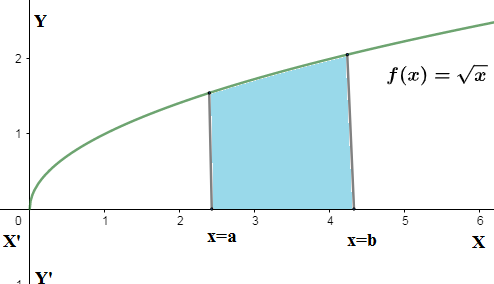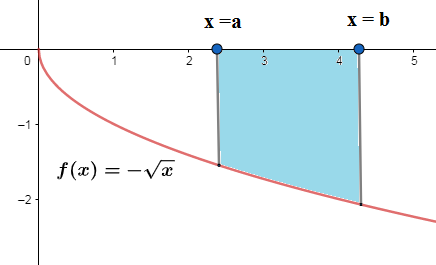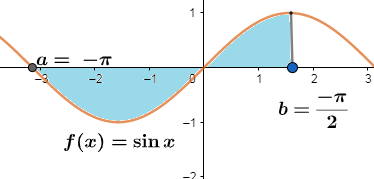Question
Question: How can a definite integral be negative? \[\]...
How can a definite integral be negative? $$$$
Solution
We recall the definition of definite integral of function f(x) with respect to x within the interval [a,b] as the area bounded by the curve and the lines x=a,x=b. We recall that area will obtained as negative if all parts of bounded region lie below x−axis or more parts of the region lie below x−axis then above x−axis.$$$$
Complete step-by-step answer:
We know that integral or primitive function of f(x) is given as F(x)+c wheredxdF(x)=f(x). If we integrate within a certain interval x∈[a,b] rather than all over the domain then we call it a definite integral and we express it as
∫abf(x)=[F(x)]ab=F(b)−F(a)
The definite integral of the function f(x) is the area of the enclosed region by the curve within the area boundsx=a,x=b. If all of the enclosed region lie above the x−axis then area as well as definite integral will be positive which means
∫abf(x)≥0 if f(x)≥0 for x∈[a,b]
We can take an example f(x)=x which is positive for the defined domain x∈(0,∞). $$$$

If all of the enclosed region lies blow the x−axis then area as well as definite integral will be negative which means
∫abf(x)≤0 if f(x)≤0 for x∈[a,b]
We can take an example f(x)=−x which is negative for the defined domain x∈(0,∞). $$$$

If the area of the enclosed region that lies below the x−axis is more than the area above the x−axis then the definite integral will be negative. If the curve intersects at some x=c∈[a,b] then we assume the area above as Aa=∫acf(x) and area below Ab=∫cbf(x). Then we have
∫abf(x)=∫acf(x)+∫cbf(x)=Aa+Ab≤0 if ∣Aa∣≤∣Ab∣
Let us consider f(x)=sinx,a=−π,b=2−π as an example. We can represent ∫−π−2−πf(x)<0 as the area shaded below. $$$$

Note: We note that the definite integration of x=f(y)within interval y∈[a,b]with respect to y will be negative if the enclosed region by the curve f(y) and the bounds y=a,y=b will be at the left side of y−axis or the area at the left side will be more than area at the right side. We can find a definite integral of functions whose indefinite integral cannot be determined with approximation.
